Despite its pretty spring flowers and its summer fruits, the horsewood is known more for the smell associated with its crushed leaves than for its attractive appearance. In South Africa it is commonly referred to by its Afrikaans name, perdepis, which literally means ‘horse piss’.
Its botanical name Clausena anisate also refers to the smell exuded by leaves that have been bruised or crushed, with anisate meaning anise or aniseed. In actual fact the smell of the leaves is not consistent across all regions, and the smell is variably described as being, for example, pungent, like horse urine, like lemon or like aniseed. And people respond to the smell differently too, with some finding it unpleasant and others not.
I don’t find the smell of the leaves on our tree unpleasant at all. I have just been outside and crushed some leaves in my hand and the smell is a kind of generalised citrusy smell, which is not surprising as the horsewood is a member of the citrus family, Rutaceae. I could not detect anything resembling aniseed, but in some regions the leaves are used to flavour curries.
Irrespective of the smell of the leaves, vervet monkeys and some birds seek out the horsewood fruit. The above photo I took from our back deck of two vervet monkeys enjoying the fruits. The large tree trunk belongs to a pigeon wood tree (Trema orientalis) and the slender horsewood is growing up around it.
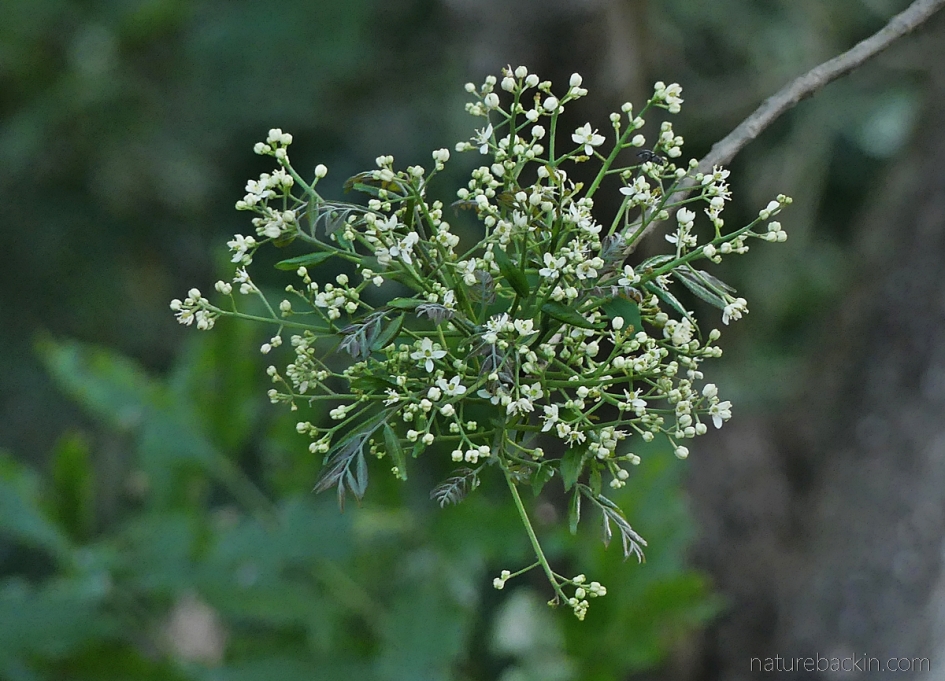
In the spring the delicate white flowers of the horsewood cluster among new leaves at the ends of willowy branches
The small flowers have a subtle sweet scent and attract many insects. The tree is one of the larval host plants of many of the swallowtail butterflies, but unfortunately I have not managed to get a usable photo of these butterflies flitting in and out among the leaves.
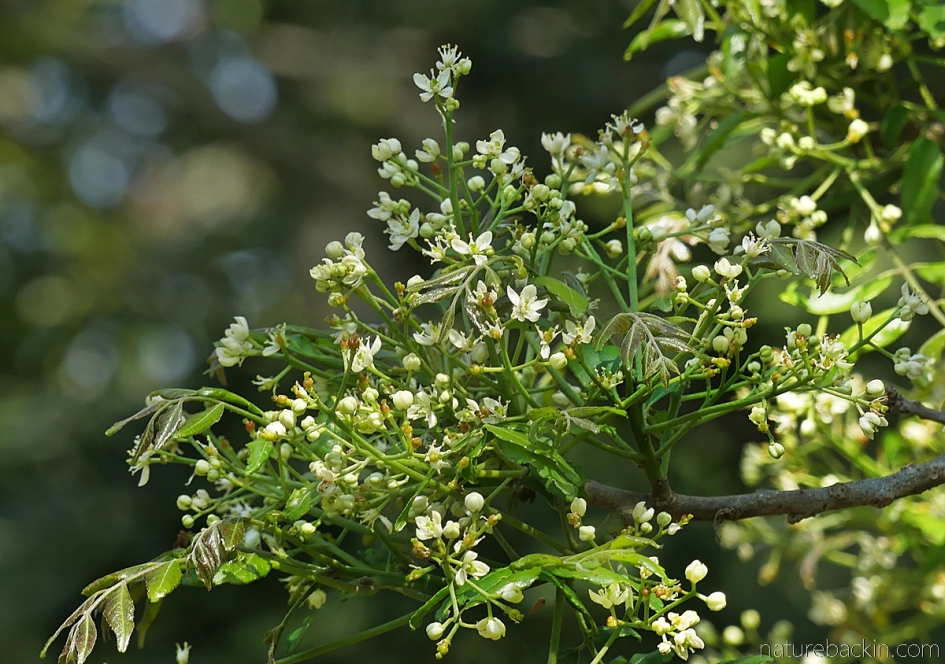
The horsewood occurs naturally in regions with relatively high rainfall and is associated with forest margins and densely vegetated areas. It is found over most of sub-Saharan Africa (but not in the arid regions) and it also occurs in India and much of South-East Asia.
Essential oils in the leaves, seeds, fruits, roots and bark contain several identified chemicals and concentrations of these chemicals within the oils vary across plants from different regions. Medicines derived from different parts of the plant are used extensively in traditional medicine, and ongoing research shows that beneficial medicinal attributes include antibacterial, antifungal and antioxidant properties. Some preparations are also effective as repellents against certain insects.
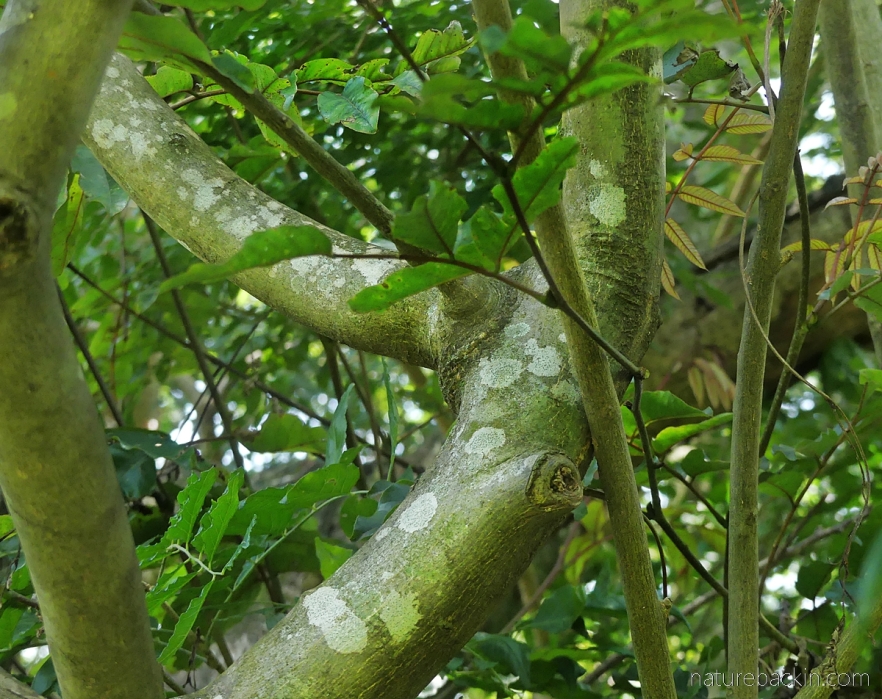
The branches and stems of the small horsewood tree that is growing in amongst some other trees on the edge of our garden are also attractive. The wood is heavy and hard and is used in hut building and the thinner stems are used to make walking sticks. Twigs, with their antiseptic properties, are used as toothbrushes.
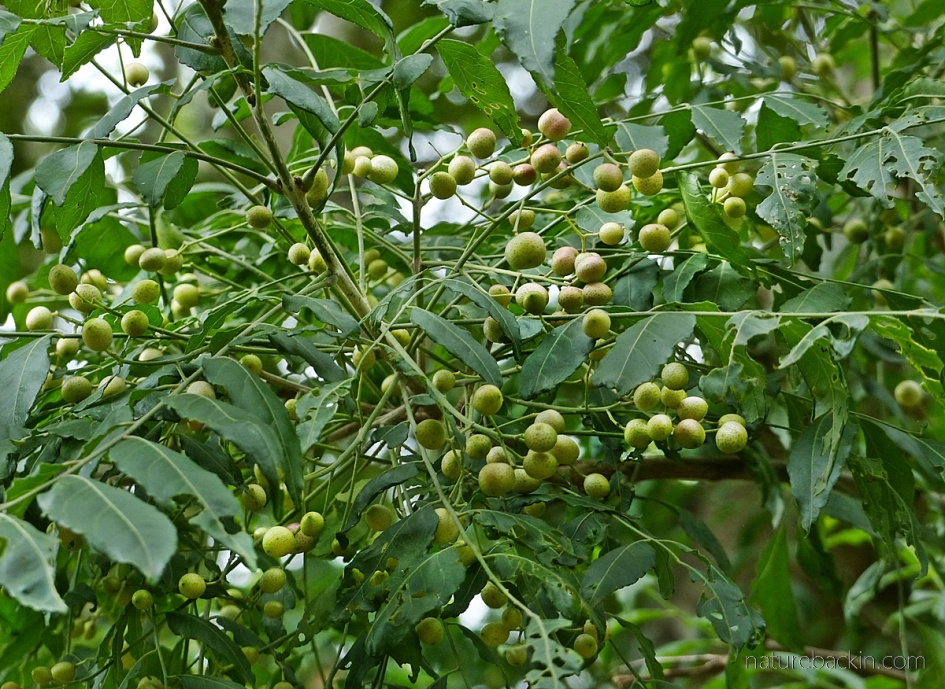
In the early summer, small fruits about the size of grapes start off green in colour and darken through purple to almost black. Interestingly, vervet monkeys enjoy eating them while they are still green, although birds seem to prefer the ripened fruit.
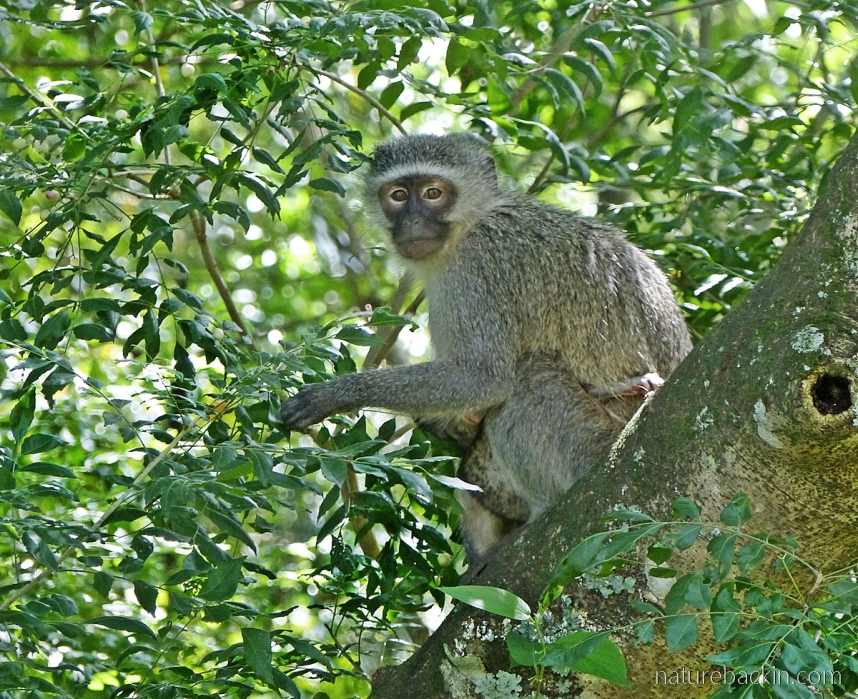
A rather soulful mother monkey, nursing a baby that is just visible, perches on the convenient trunk of the pigeon wood tree as she picks some green fruits from the horsewood.
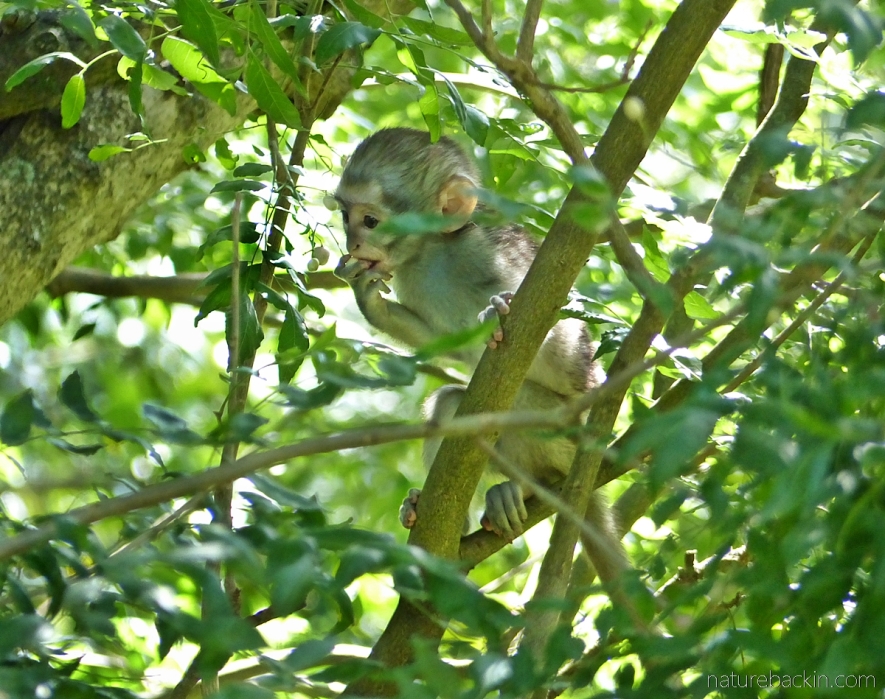
The mother released her young baby who managed to clamber about rather awkwardly to pick and eat green fruit

At another time this big fella also made use of the pigeon wood trunk as a perch while picking and eating horsewood fruit

Fruits of different degrees of ripeness hang in clusters on our horsewood tree
Unfortunately the recent hailstorm took place at peak fruiting time and knocked off most of the fruits before they had a chance to ripen, so pickings have been very thin this year. It was only reading for this post that I discovered that the slightly sweet fruits are edible for humans too. I will try them next season.
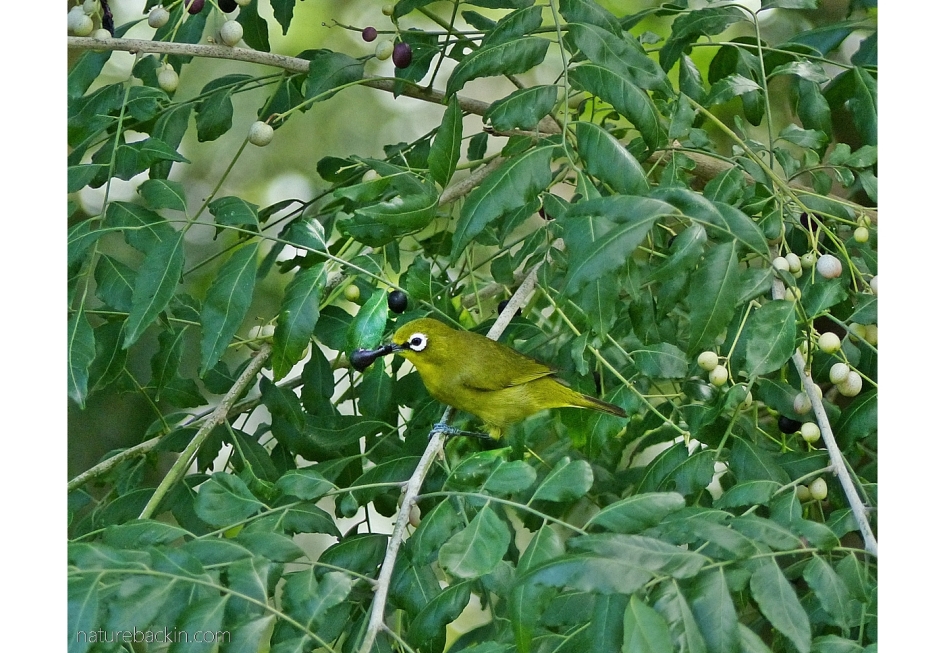
The birds move so quickly when foraging for fruit so this is the best I managed to do when photographing Cape white-eyes selecting the ripest fruit to eat in the horsewood tree
The horsewood is deciduous in regions that have a long dry season, and that is the case here. It is a lovely tree, well suited to a spot in shade or semi-shade in a small garden, and great for attracting a variety of birds and pollinating insects, as well as hosting swallow-tailed butterflies that lay their eggs on the leaves.

Sources:
Boon, Richard. 2010 (2nd ed.). Pooley’s Trees of Eastern South Africa. Durban: Flora & Fauna; Tchinda, A.T., 2011. Clausena anisata (Willd.) Hook.f. ex Benth. In: Schmelzer, G.H. & Gurib-Fakim, A. (Editors). PROTA (Plant Resources of Tropical Africa / Ressources végétales de l’Afrique tropicale), Wageningen, Netherlands. https://uses.plantnet-project.org/en/Clausena_anisata_(PROTA); Tropical Plants Database, Ken Fern. tropical.theferns.info. http://tropical.theferns.info/viewtropical.php?id=Clausena+anisata
Posted by Carol

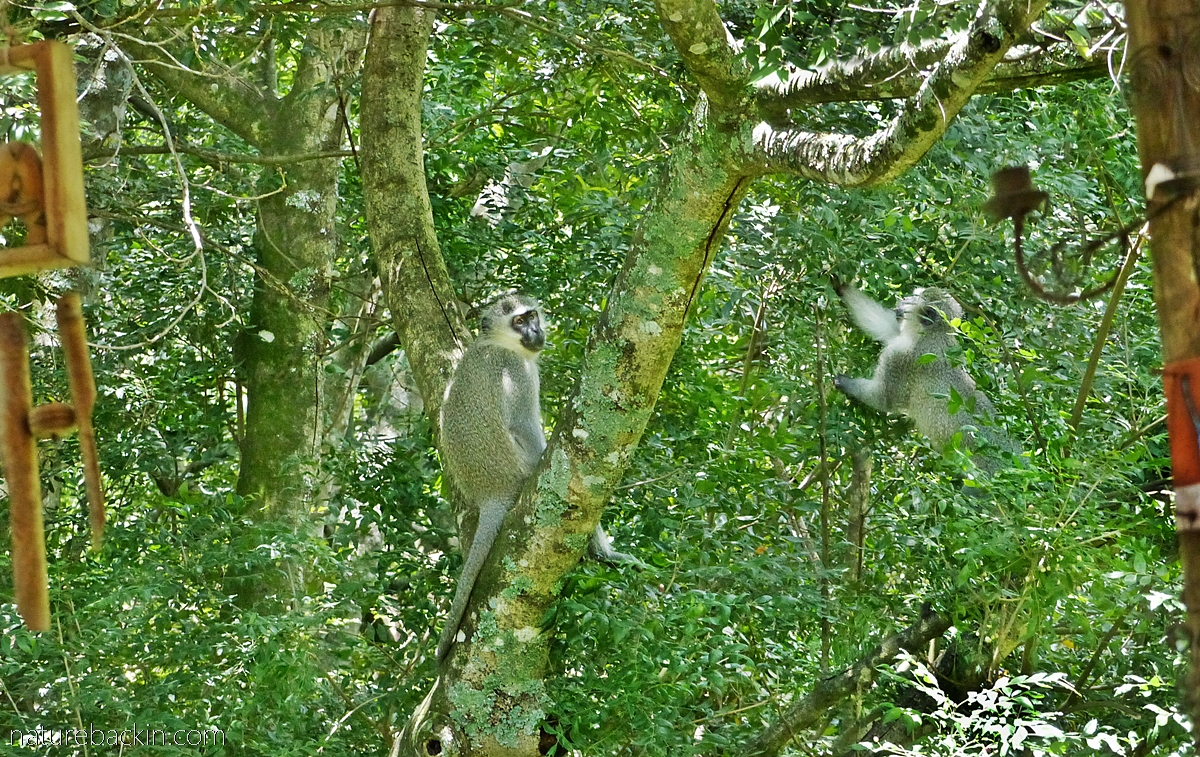




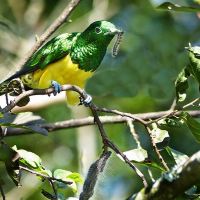
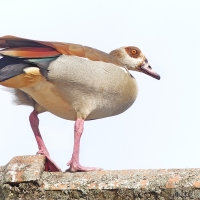

January 23, 2021 at 10:05 pm
It’s so good to be back! I’m afraid I fell into a bit of a funk this past year and am just crawling back out of that hole now. I’m so glad I didn’t miss this post. What an utterly splendid tree you have there. I could almost imagine being there watching those delightful monkeys and the delicate flowers. It’s sometimes difficult to wrap my head around the fact that as your summer is apparently waning, I am eagerly awaiting a glorious springtime. What a blessing to have nature’s wonders close at hand.
Sending wishes for health and delight.
LikeLiked by 1 person
January 24, 2021 at 8:01 pm
Hi Gunta – I am sure it must help to have springtime to look forward to!
It is an interesting tree and this week it is hosting a collection of very vocal cicadas and to my surprise they allowed themselves to be very visible – usually they are so hard to see. Seeing such natural sights is indeed a blessing.
Thanks for your good wishes and I return the same to you. Let’s hope this turns out to be a much better year …
LikeLiked by 1 person
January 7, 2021 at 4:58 pm
For your sake I hope the fruit taste better than the leaves are reported to smell… Please tell us next year, Carol? 😀
Just teasing. This really was an eye-opener of a post for me, Carol. The fruit are familiar and I know the Afrikaans name, but I never put two and two together. I am enlightened.
LikeLiked by 1 person
January 7, 2021 at 8:02 pm
Well here is hoping the fruit tastes better!
Yesterday I spotted a few flowers (I think the recent hail storm has caused some plants to do unusual things in compensation for being damaged) and so its possible there maybe a fruit or two to sample sooner than I thought! I will let you know.
I only put two and two together re this tree from information we were given on a guided conservancy walk in the Midlands.
LikeLiked by 1 person
December 20, 2020 at 12:04 pm
Another enchanting post. I am glad to know the more polite common name for Perdepis and to have learnt about its various uses. Thanks Carol
LikeLiked by 1 person
December 21, 2020 at 2:17 pm
The thing about the more polite name is that I have never heard it used! 🙂
LikeLiked by 1 person
December 19, 2020 at 12:18 pm
An interesting post. I can recall hearing the ‘perdepis’ name, but cannot recall ever seeing or identifying it. Lovely photos of the Vervets! I’d also be interested to hear from you about the taste of the berries.
LikeLiked by 1 person
December 21, 2020 at 2:15 pm
Thanks – and I will report back on the berries!
LikeLiked by 1 person
December 18, 2020 at 4:30 pm
A new tree to me, but anything that attracts birds and butterflies, and smells like lemon or aniseed would welcome as far as I’m concerned.
LikeLiked by 1 person
December 19, 2020 at 5:43 am
I agree on everything except the aniseed! I have never managed to acquire a taste for it.
LikeLiked by 1 person
December 19, 2020 at 7:07 pm
Aniseed is one of my favorites, even when I was a kid, and there were a lot of things I wouldn’t touch back then!
LikeLiked by 1 person
December 21, 2020 at 2:16 pm
Perhaps I should experiment with it in a curry!
LikeLiked by 1 person
December 22, 2020 at 6:07 am
A couple of weeks ago I made a chicken curry with three star anise in it (amongst many other things). Tasty!
LikeLiked by 1 person
December 22, 2020 at 9:29 pm
Oh dear I think I’ve muddled up not liking caraway seeds with aniseed. I do use star anise in curry afterall! Delete delete delete.
LikeLiked by 1 person
December 23, 2020 at 3:10 am
I guess aniseed, star anise, and caraway, among others, are from different plants but have similar flavor. The strength of that flavor and the side notes or flavors make the difference, or so I read. Maybe you don’t need to delete after all!
LikeLiked by 1 person
December 18, 2020 at 8:34 am
You do seem to go in for multi-tasking trees in your part of the world. Don’ forget to tell us how you get on with eating the fruits next year.
LikeLiked by 1 person
December 19, 2020 at 5:41 am
I will try to remember. Next summer seems to be a world away …
LikeLiked by 1 person
December 18, 2020 at 4:41 am
This is an interesting look at a tree I know of but am not familiar with – thank you for that. Having mature trees nearby is a blessing.
LikeLiked by 1 person
December 19, 2020 at 5:38 am
Thanks Anne. We are always grateful to the previous owners of our house for their extensive planting of indigenous trees and shrubs both in the garden and on its margins.
LikeLike
December 18, 2020 at 3:53 am
This was one of the first indigenous trees I consciously learnt the name of, I was fascinated by the astringent smell of the crushed leaves. Thank you Carol for deepening the knowledge. xxx
LikeLiked by 1 person
December 19, 2020 at 5:34 am
Thanks Christeen. When we first moved here I could not ID the tree in our garden. But then one was identified for us on a guided walk in the Dargle Conservancy and the mystery was solved ☺
LikeLiked by 1 person
December 18, 2020 at 12:03 am
Seems like a very useful, as well as attractive, plant. The mother vervet is so pretty and her infant is adorable. It must be fun to see monkeys in the garden.
LikeLiked by 1 person
December 19, 2020 at 5:31 am
It is particularly special to watch the monkeys with their babies. The mothers are very protective and affectionate.
LikeLike
December 17, 2020 at 10:07 pm
A tree with so many attributes, and one that is unheard of here. I love the idea of having monkeys in the trees at the end of the garden!
LikeLiked by 1 person
December 19, 2020 at 5:24 am
Btw, one article I read said the tree can be found occurring naturally in Queens land but it was the only one I found that mentioned that. We love seeing the monkeys foraging although there are many people that dislike them, sadly.
LikeLiked by 2 people
December 19, 2020 at 12:15 pm
Interesting that it occurs in Queensland! I will see if I can find out more information on it.
LikeLiked by 1 person
December 17, 2020 at 7:35 pm
Beautiful. 🙏❣
LikeLiked by 1 person
December 17, 2020 at 7:42 pm
Thanks very much!
LikeLiked by 1 person